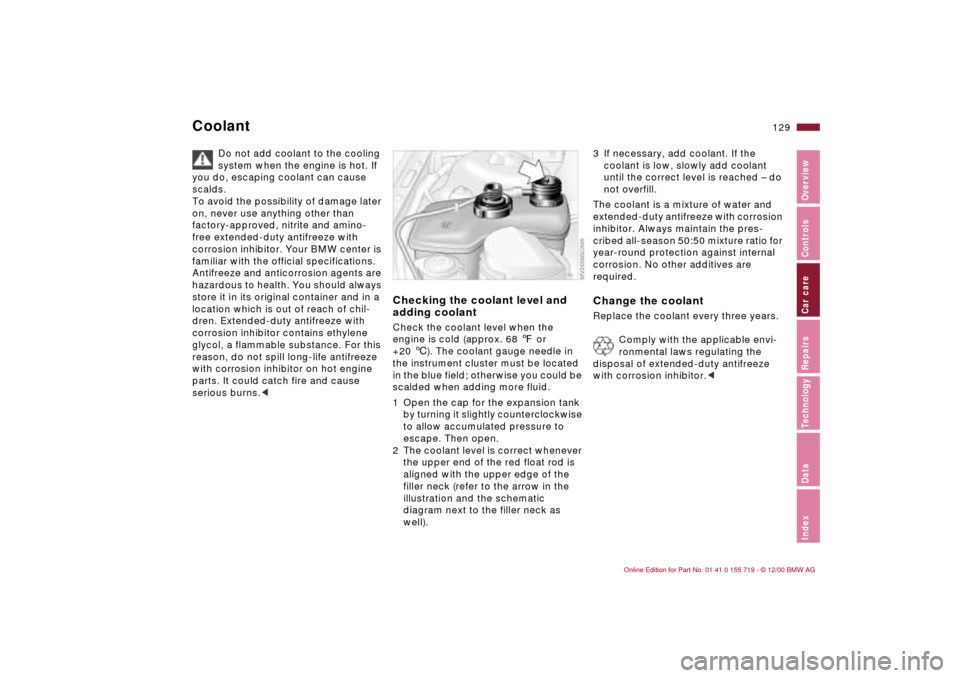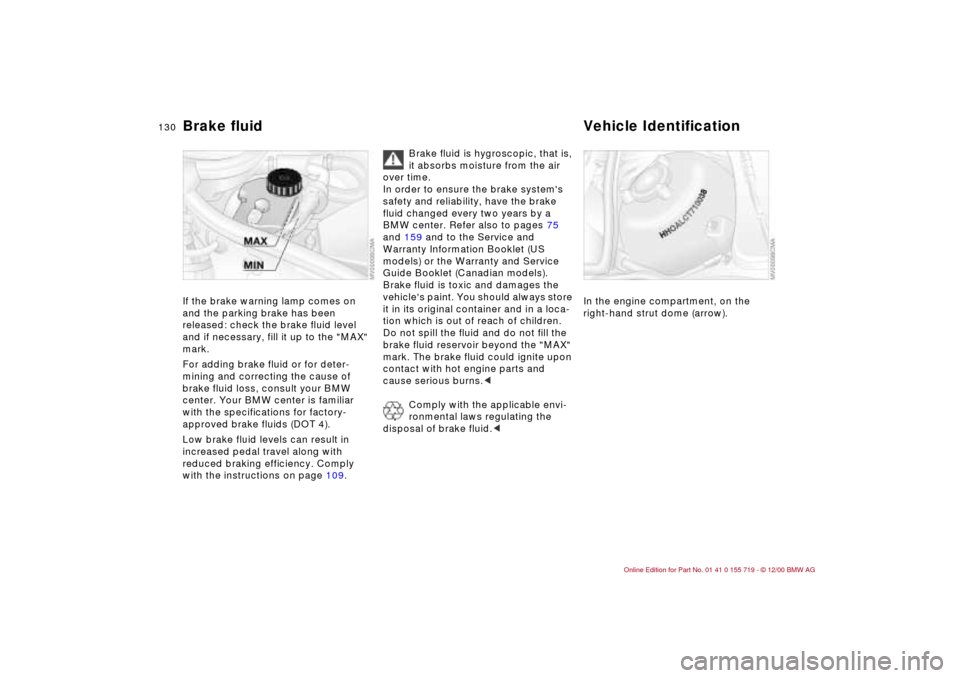2001 BMW M3 CONVERTIBLE check engine
[x] Cancel search: check enginePage 107 of 195

107n
IndexDataTechnologyRepairsCar careControlsOverview
Antilock Brake System (ABS)Antilock Brake System (ABS)/
Cornering Brake Control (CBC) CBC is an advanced engineering
feature of the ABS. When braking while
cornering at high speed or braking
during high lateral acceleration in
curves, or when braking during a lane
change, vehicle stability is improved
and steering response is enhanced.
In the event of a malfunction
If the ABS warning lamp comes
on, refer to page 21. The brake
system will continue to function
the same as on vehicles without ABS.
However, have the brake system
checked by your BMW center as soon
as possible. To prevent undetected
defects and cumulative faults from
adversely affecting the brake system,
refer any problems to your BMW center
at the earliest opportunity.
ABS warning lamp for Canadian
models.
If the brake warning lamp
comes on together with the indi-
cator lamps for ABS and DSC,
refer to page 21: then the entire
ABS, CBC and DSC
control
system has failed. Continue
driving cautiously and defen-
sively. Avoid full brake applica-
tions. This could cause the vehicle to
lose stability and you might no longer
be able to control it.
Have the system checked by your BMW
center as soon as possible.
CBC, ABS and DSC indicator
and warning lamps for Canadian
models.
Page 127 of 195

127n
IndexDataTechnologyRepairsCar careControlsOverview
Engine oilChecking oil level 1 Park the vehicle on a level surface
2 Shut the engine off after it has
reached normal operating tempera-
ture
3 After approx. one minute, pull the
dipstick out and wipe it off with a
clean lint-free cloth, paper towel, or
similar material
4 Carefully push the dipstick all the way
into the guide tube and pull it out
again
5 The oil level should be between the
two marks on the dipstick.
As with fuel economy, oil consumption
is directly influenced by your driving
style and vehicle operating conditions.
The oil volume between the two marks
on the dipstick corresponds to approx.
1.4 US quarts (1.3 liters).
Adding engine oil Wait until the level has dropped to just
above the lower mark before adding oil.
However, never let the oil drop below
the lower mark.
Do not fill beyond the upper mark on
the dipstick. Excess oil will damage the
engine.
To obtain a correct reading when
rechecking the oil level after adding
lubricant, start the engine and allow it
to run, then switch it off and proceed as
described in the section on "Checking
oil level".
BMW engines are designed to
operate without oil additives; the
use of additives could lead to damage
in some cases. This is also true for the
Page 129 of 195

129n
IndexDataTechnologyRepairsCar careControlsOverview
Coolant
Do not add coolant to the cooling
system when the engine is hot. If
you do, escaping coolant can cause
scalds.
To avoid the possibility of damage later
on, never use anything other than
factory-approved, nitrite and amino-
free extended-duty antifreeze with
corrosion inhibitor. Your BMW center is
familiar with the official specifications.
Antifreeze and anticorrosion agents are
hazardous to health. You should always
store it in its original container and in a
location which is out of reach of chil-
dren. Extended-duty antifreeze with
corrosion inhibitor contains ethylene
glycol, a flammable substance. For this
reason, do not spill long-life antifreeze
with corrosion inhibitor on hot engine
parts. It could catch fire and cause
serious burns.<
Checking the coolant level and
adding coolant
Check the coolant level when the
engine is cold (approx. 68 7 or
+20 6). The coolant gauge needle in
the instrument cluster must be located
in the blue field; otherwise you could be
scalded when adding more fluid.
1 Open the cap for the expansion tank
by turning it slightly counterclockwise
to allow accumulated pressure to
escape. Then open.
2 The coolant level is correct whenever
the upper end of the red float rod is
aligned with the upper edge of the
filler neck (refer to the arrow in the
illustration and the schematic
diagram next to the filler neck as
well).
3 If necessary, add coolant. If the
coolant is low, slowly add coolant
until the correct level is reached – do
not overfill.
The coolant is a mixture of water and
extended-duty antifreeze with corrosion
inhibitor. Always maintain the pres-
cribed all-season 50:50 mixture ratio for
year-round protection against internal
corrosion. No other additives are
required. Change the coolantReplace the coolant every three years.
Comply with the applicable envi-
ronmental laws regulating the
disposal of extended-duty antifreeze
with corrosion inhibitor.<
Page 130 of 195

130n
Brake fluid Vehicle Identification If the brake warning lamp comes on
and the parking brake has been
released: check the brake fluid level
and if necessary, fill it up to the "MAX"
mark.
For adding brake fluid or for deter-
mining and correcting the cause of
brake fluid loss, consult your BMW
center. Your BMW center is familiar
with the specifications for factory-
approved brake fluids (DOT 4).
Low brake fluid levels can result in
increased pedal travel along with
reduced braking efficiency. Comply
with the instructions on page 109.
Brake fluid is hygroscopic, that is,
it absorbs moisture from the air
over time.
In order to ensure the brake system's
safety and reliability, have the brake
fluid changed every two years by a
BMW center. Refer also to pages 75
and 159 and to the Service and
Warranty Information Booklet (US
models) or the Warranty and Service
Guide Booklet (Canadian models).
Brake fluid is toxic and damages the
vehicle's paint. You should always store
it in its original container and in a loca-
tion which is out of reach of children.
Do not spill the fluid and do not fill the
brake fluid reservoir beyond the "MAX"
mark. The brake fluid could ignite upon
contact with hot engine parts and
cause serious burns.<
Comply with the applicable envi-
ronmental laws regulating the
disposal of brake fluid.<
In the engine compartment, on the
right-hand strut dome (arrow).
Page 131 of 195

131n
IndexDataTechnologyRepairsCar careControlsOverview
The BMW Maintenance System has
been designed as a reliable means of
providing maximum driving and oper-
ating safety – and as cost-effectively as
possible for you.
Please keep in mind that regular main-
tenance is not only necessary for the
safety of your vehicle, but also plays a
significant role in maintaining the resale
value of the vehicle. Service Interval DisplayAdvanced technology is employed to
calculate the optimal maintenance
intervals. These are then indicated in
the Service Interval Display. While
conventional systems rely solely on
distance traveled to determine when
service is due, the BMW Maintenance
System considers the actual conditions
under which the vehicle operates,
because miles can be traveled in many
different ways:
From the point of view of maintenance,
for example, 62,000 miles (100,000 km)
short-distance driving are not equal to
the same 62,000 miles (100,000 km) of
long-distance travel.
The BMW Maintenance System
includes the Engine Oil Service and
Inspections I and II.
Determining the maintenance intervals
according to the actual use of the
vehicle covers every kind of operating
situation. Those who are outright
"Sunday drivers," driving fewer than
6,000 miles (10,000 km) per year –
should, nevertheless have their oil
changed every 2 years at the most, no
matter what the Service Interval Display
indicates, since engine oil breaks down
over time, regardless of use. Service and Warranty Information
Booklet (US models)/Warranty
and Service Guide Booklet (Cana-
dian models)For additional information on required
maintenance intervals and procedures,
please refer to the Service and Warranty Information Booklet
(US models), or the Warranty and
Service Guide Booklet (Canadian
models).
As a precaution against rust, it is advis-
able to have the body checked for
damage from rocks or gravel at the
same time, depending upon operating
conditions.
Have your BMW center perform
maintenance and repair.
Your BMW center is always informed on
the latest maintenance work and repair
techniques and equipped with the
required special tools. In addition,
checking parts known from experience
to be subject to wear is a permanent
part of the maintenance specifications.
Be sure that all maintenance work is
confirmed in the Service and Warranty
Information Booklet (US models), or in
the Warranty and Service Guide
Booklet (Canadian models). These
entries are your verification for the
regular maintenance of your vehicle
and are required for the performance of
warranty repairs.<
The BMW Maintenance System
Page 140 of 195

140n
Storing your vehicle
If you intend to store the vehicle
for more than 3 months, be sure to
follow the maintenance instructions on
this page.<
Storage preparationsHave your BMW center perform the
following procedures:
1 Clean and apply a rustproofing agent
or other treatment to the engine,
engine compartment, undercarriage,
axles and major components in
accordance with approved repair
procedures. First wash the vehicle
surface, then clean the interior,
following up with paint- and chrome
care, after which you clean the
rubber seals for the hood and doors.
2 Change the engine oil and oil filter
with the engine warm. As an addi-
tional corrosion protection measure,
an anticorrosive agent can be added
to the engine in accordance with the
manufacturer's instructions.
3 Check the coolant level and concen-
tration, top up if necessary.
4 Check the fluid level of the wind-
shield washer fluid reservoir; top up if
necessary.
5 Fill the fuel tank completely to
prevent the formation of condensa-
tion.
6 Increase the tire inflation pressure to
51 psi (350 Kilopascal).Before parking the vehicle1 To prevent the brake discs and
drums from corroding, dry the
parking and footbrake by applying
the brakes.
2 Park the vehicle in a covered, dry,
and well-ventilated area. Place the
transmission in first gear or, if neces-
sary, chock the wheels to prevent the
vehicle from rolling. Do not set the
parking brake.
3 Remove the battery, charge it
completely and store it in a cool (but
frost-free) room.
4 Remove the hardtop and store it
separately. Refer to page 114.
5 Close the convertible top.During storageRecharge the battery every six months.
If it is not recharged, it will not be
useable. Every time the battery is
discharged, especially over extended
periods, its service life is reduced.
Removing the vehicle from
storageRecharge the battery if the "Magic
Eye
*" turns black. Refer to page 157.
Then have Inspection I performed by
your BMW center, including a brake
fluid replacement if necessary.
Page 142 of 195

142n
OBD connector The data link connector for onboard
diagnostics is located on the left-hand
side of the driver's side, on the under-
side of the instrument panel and under
a cover panel. The cover has the letters
"OBD" on it.
The purpose of the OBD system is to
assure proper emission control system
operation for the vehicle's lifetime by
monitoring emission-related compo-
nents and systems for deterioration and
malfunction.
An illuminated indicator informs
you of the need for service, not
that you need to stop the
vehicle. Your system should be
checked, however, at the earliest
possible opportunity.
If the indicator blinks or flashes, this
indicates a high level of engine misfire.
Reduce speed and contact your
nearest BMW center immediately.
Severe engine misfiring over even a
short period of time can seriously
damage emission control system
components, especially the catalytic
converter.
"Service Engine Soon" warning
lamp for Canadian models.
If the fuel filler cap is not on tight
enough, the OBD system can
detect leaking vapor and the indicator
will light up.
If the fuel filler cap is then tightened,
the indicator will usually go out after a
short period of time.<
Page 186 of 195

Everything from A to ZAABS (Antilock Brake
System)21, 106
Acceleration181
Accessories6
Activated-charcoal filter92
replacing161t
Adding
brake fluid125t, 130t
coolant129t
engine oil127t
washer fluid126t, 181
Adjusting
clock76
head restraints50
interior temperature90
steering wheel55
thigh support area49
Adjusting seats
lumbar support49
Air conditioner91
Air distribution,
automatic90
Air outlets88
Air pressure115
Air supply91
recirculated air mode91
vents91
Airbags61, 139, 168
warning lamp21, 22Alarm system42
avoiding unintentional
alarms43
indicator lamp43
interior motion sensor42
tilt sensor alarm
system42
Alcantara care136
Antenna112
Antenna, Diversity169
Antifreeze129
radiator110
Antilock Brake System
(ABS)21, 106
Anti-theft alarm system42
Anti-theft protection33
Approved wheel and tire
specifications120
Aquaplaning105, 115
Armrest95
Ashtray
front96
rear97
AUC (Automatic recirculated
air control)91
Automatic climate
control88
Automatic cruise
control71
Automatic recirculated air
control (AUC)91Automatic windshield
washer70
Auxiliary terminal for jump-
starting125t
Average fuel
consumption78
Average speed78
Axle loads180
BBackrest
releasing51
Backup lamps68
replacing bulb149t
Battery157, 182
add distilled water157t
capacity182
charging159t
current check lamp20
removal and
installation158
symbols158
Belts57
Beverage holder95
BMW High Performance
Synthetic Oils128
BMW Maintenance
System131
BMW Sports seat49
Bore178Bottle holder, refer to
Beverage holder
Brake system20, 109
ABS21t, 106
brake faults109t
brake fluid change75
brake fluid level, warning
lamp20, 109
brake lamp, center151
brake lamps, replacing
bulb149t
brake pads, indicator
lamp22, 109
disc brakes108
driving notes105
warning lamp20, 109
Break-in procedure104
Bulbs and lamps146
CCalifornia Proposition
65 Warning141
Can holder, refer to
Beverage holder
Capacities181
Car battery182
Car Memory55
Car radio112
reception113, 169
refer also to the separate
Owner's Manual